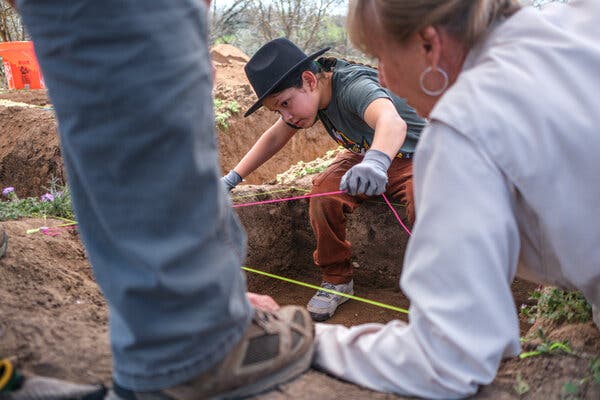Paint Rock, an ancient ceremonial site in Central Texas, is a sort of outdoor gallery of rock art that documents hundreds or even thousands of years of Native American heritage. Spread out over half a mile on a bluff 70 feet above the Concho River, Paint Rock derives its name from the pictographs on the layers of limestone shelves. Using massive flat-faced boulders as canvases, nomadic tribes painted and etched more than 1,500 individual images — tomahawks, winged serpents, a Spanish mission, a turtle drawn so that, on the winter solstice, a dagger of light strikes its back at solar noon, the moment when the sun sits highest in the sky.
In March, scores of people from the region — mostly Coahuiltecan, Comanche and Lipan Apache — joined dozens of researchers for a four-day excavation at Paint Rock. Mary Motah Weahkee, a member of the Comanche Nation and Santa Clara Pueblo tribes and a retired archaeologist for the State of New Mexico, attended the gathering to “inspire Comanche youth and elders to visit our history by praying, singing and sleeping at the site,” she said. She also performed in a rain-dance ritual. “I made it flood in a town 20 minutes away,” she said.
Scholars suggest that Native groups occupied the bluffs in two broad periods, one during the Late Archaic, from roughly 600 B.C. to 200 A.D., and again in the Late Prehistoric, from 800 A.D. to 1700 A.D. As many as 300 different tribes camped at Paint Rock, some as recently as 1865, when advancing settlers drove the last Comanches from the area.
In 1856, Robert E. Lee and his troops bivouacked at Paint Rock’s western springs. “A previous archaeological investigation in the 1990s found fragments of a certain type of dinnerware that Lee was known to bring with him on his travels,” said Eric Schroeder, editor of the Bulletin of the Texas Archeological Society. Although no pictographs relate to Lee’s visit, some well-known cavalry soldiers and land surveyors left their autographs on the cliff face next to and sometimes on top a few of the paintings.
